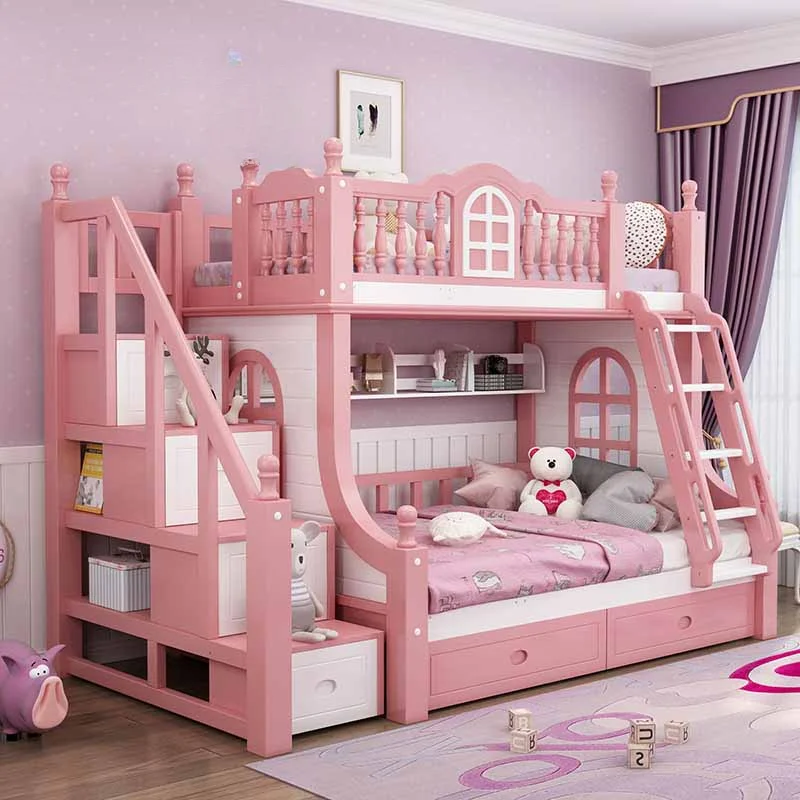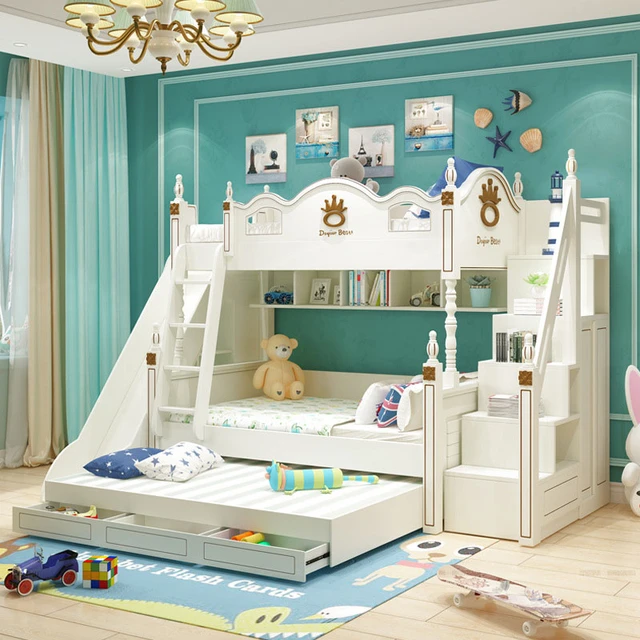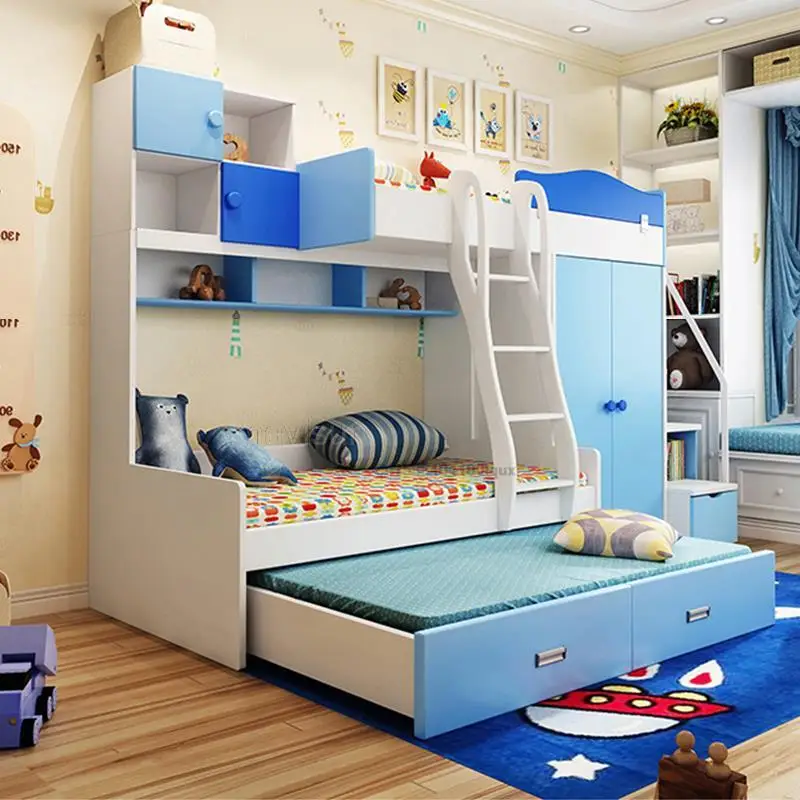Bunk bed for kids
Bunk beds have long been a staple in children’s bedrooms, offering a space-saving solution and a fun, whimsical element to the décor. From classic wooden frames to modern, colorful designs, bunk beds come in a wide variety of styles to suit any taste and budget. This article will explore the benefits and considerations of bunk beds for kids, examining their practicality, safety, and overall impact on the bedroom environment.
 The Practical Advantages of Bunk Beds
The Practical Advantages of Bunk Beds
One of the primary reasons parents choose bunk beds is to maximize space in a child’s bedroom. By stacking sleeping areas, bunk beds free up floor space for play, study, or storage. This is especially beneficial in smaller homes or rooms where space is at a premium. Here’s a breakdown of the practical benefits:
- Space Optimization: Bunk beds are the ultimate space-saving solution for children’s bedrooms, particularly when sharing a room. They make the most of vertical space, allowing for more floor area for activities and storage solutions.
- Storage Solutions: Many bunk beds come with built-in storage options, such as drawers, shelves, or a ladder with built-in steps. This can help keep the room tidy and organized by providing designated areas for toys, books, and clothing.
- Increased Play Area: The freed-up floor space can be used to create a dedicated play area, allowing children to spread out and engage in imaginative play without feeling cramped.
- Versatility: Bunk beds can evolve with a child’s needs. The lower bunk can be transformed into a reading nook, a play area, or even a desk as the child gets older.
Ensuring Safety with Bunk Beds
While bunk beds offer many practical advantages, safety is a paramount concern. It’s essential to choose a bunk bed that meets safety standards and take steps to minimize potential hazards. Here are some crucial safety considerations:
- Choose a Sturdy Bed: Opt for bunk beds made from durable materials like solid wood or metal, ensuring they can withstand the weight and movement of children.
- Guardrails: Guardrails are essential for the top bunk, particularly for younger children. Ensure they are high enough to prevent accidental falls and sturdy enough to support the child’s weight.
- Ladder Stability: The ladder should be secure and have handrails for stability. The ladder should also be positioned close to the bed, making it easy for children to climb up and down safely.
- Mattress Fit: The mattresses must fit snugly in the bed frames to prevent gaps or overhangs that could create a tripping hazard.
- Proper Anchoring: Secure the bunk bed to the wall using anti-tip brackets, especially in rooms with uneven floors or where there is a risk of the bed being moved.
 Bunk Beds for Different Ages and Needs
Bunk Beds for Different Ages and Needs
Bunk beds are not a one-size-fits-all solution. The right bunk bed for a child will depend on their age, size, and individual needs. Here’s a look at different types of bunk beds and their suitability for various ages:
- Toddler Bunk Beds: While not common, some companies offer bunk beds designed for toddlers. These often have shorter heights and more rounded edges to prevent injuries.
- Standard Bunk Beds: These are the most popular type of bunk bed, suitable for children aged six and up. They offer a standard height and are available in a wide range of styles.
- Loft Beds: Loft beds feature a raised platform for the top bunk, creating space underneath for a desk, play area, or storage. Loft beds are often preferred by older children who require more space and privacy.
- Triple Bunk Beds: These beds offer three sleeping areas, ideal for families with multiple children or for sleepovers. Triple bunk beds are typically recommended for older children due to the added height and potential safety concerns.
Choosing the Right Bunk Bed
When selecting a bunk bed for your child, consider these factors:
- Age and Size: Choose a bed that is appropriate for your child’s age and size, considering their developmental stage and physical abilities.
- Safety Features: Prioritize safety features such as guardrails, sturdy ladders, and proper anchoring.
- Space Requirements: Measure your child’s bedroom carefully to ensure the bunk bed fits comfortably without obstructing doorways or windows.
- Style and Aesthetics: Choose a bed that complements your child’s personality and the overall décor of the bedroom.
- Budget: Bunk beds come in a wide range of prices. Determine a budget and explore options within that range.
 The Impact of Bunk Beds on a Child’s Bedroom
The Impact of Bunk Beds on a Child’s Bedroom
Bunk beds can significantly impact the overall atmosphere and functionality of a child’s bedroom:
- Fun and Excitement: Bunk beds are often seen as a fun and exciting addition to a child’s room, creating a sense of adventure and a unique space for sleep and play.
- Sense of Privacy: The top bunk can offer a sense of privacy and a personal space for a child, especially when sharing a room.
- Encourages Imagination: The unique structure of bunk beds can encourage imaginative play, with the top bunk becoming a treehouse, a pirate ship, or a secret hideaway.
- Organization and Tidiness: Bunk beds with built-in storage can help children develop good organizational habits and keep their rooms tidy.
- Multifunctionality: Bunk beds can adapt to a child’s evolving needs, serving as a sleeping area, play area, study space, or storage solution.
Some tips on how to choose a bunk bed for kids:
Here are some tips on how to choose a bunk bed for kids:
Safety First
- Stability and Strength: Look for bunk beds made from sturdy materials like solid wood or metal. Check for a strong, stable frame and ensure it meets safety standards.
- Guardrails: Guardrails are essential for preventing falls, especially for younger children. Make sure they are high enough and have a secure latch.
- Ladder: Choose a ladder that is sturdy and has secure steps. Consider a ladder with handrails for extra stability.
- Mattress Size and Fit: Ensure the mattresses fit snugly into the bed frame to prevent gaps and potential hazards.
- Distance Between Bunks: The space between the top and bottom bunk should be sufficient to prevent a child from getting trapped.
- Weight Limits: Check the manufacturer’s weight limit for each bunk and make sure it meets the needs of your children.
 Consider Your Children’s Needs
Consider Your Children’s Needs
- Age and Size: Choose a bunk bed appropriate for the ages and sizes of your children.
- Space: Measure the room carefully to ensure the bunk bed fits comfortably.
- Style and Design: Choose a style and design that complements your children’s personalities and the overall aesthetic of the room.
- Features: Some bunk beds come with additional features like built-in storage, desks, or reading lights. Consider your children’s needs and the functionality you require.
Other Considerations
- Budget: Determine a budget before you start shopping to help you narrow down your options.
- Assembly: Consider the assembly process. Some bunk beds are easier to put together than others.
- Warranty: Check the manufacturer’s warranty in case you need to make a claim.
Tips for Choosing the Right Bunk Bed for Your Kids
- Read Reviews: Check online reviews to see what other customers have said about specific bunk beds.
- Shop Around: Compare prices and features from different retailers.
- Ask for Help: If you’re unsure about which bunk bed is right for your family, ask a salesperson for guidance.
Remember, choosing the right bunk bed can create a safe and fun space for your children to sleep and play. By following these tips, you can find a bunk bed that meets your needs and your children’s needs.
Some current trends for kids’ bunk beds:
Here are some current trends for kids’ bunk beds:
Design & Aesthetics:
- Modern and Minimalist: Sleek lines, simple shapes, and a focus on functionality are popular. This often includes neutral color palettes with pops of color through bedding or accessories.
- Rustic and Farmhouse: Warm wood tones, distressed finishes, and farmhouse-inspired details are trendy. These beds often have a cozy and inviting feel.
- Industrial Chic: Metal accents, exposed pipes, and a mix of materials create a cool and edgy look.
- Personalized and Unique: Kids are increasingly wanting bunk beds that reflect their individual personalities and interests. This can be achieved through custom paint jobs, unique bed frames, or themed decorations.
Features & Functionality:
- Built-in Storage: Bunk beds with drawers, shelves, or cubbies provide ample storage space for toys, clothes, and other essentials.
- Convertible Beds: Beds that can be converted into twin beds as kids grow older are becoming increasingly popular.
- Safety Features: Features like guard rails, ladders with sturdy handrails, and non-toxic materials are paramount for safety.
- Sustainable Materials: Parents are increasingly choosing bunk beds made from sustainable and eco-friendly materials.
Themes & Styles:
- Loft Beds with Play Areas: Beds with a built-in desk, play area, or even a slide are a popular choice for younger children.
- Fort-Style Bunk Beds: These beds often feature curtains, drapes, or other elements that create a cozy and imaginative space for kids to relax and play.
- Themed Bunk Beds: Bunk beds with specific themes, like pirates, princesses, or sports, are popular for kids who love to dream and explore.
Additional Trends:
- Smart Features: Some bunk beds now include features like integrated lighting, Bluetooth speakers, or even charging stations for electronics.
- Sustainable and Eco-Friendly Materials: Bamboo, recycled wood, and other sustainable materials are gaining popularity in bunk bed construction.
Remember, the best bunk bed for your child will depend on their individual needs and preferences. Consider their age, personality, and the space available in their bedroom when choosing the perfect bunk bed.
 Conclusion
Conclusion
Bunk beds offer a practical, fun, and versatile solution for children’s bedrooms. They maximize space, promote safety, and foster creativity. When selecting a bunk bed, prioritize safety, consider your child’s age and needs, and choose a bed that complements their personality and the overall room design. With careful consideration, bunk beds can become a cherished part of a child’s room, creating a space for rest, play, and development.


